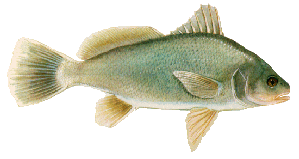Freshwater Drum (Aplodinotus grunniens)
- Other Names
- Drum Fish, Gaspergou, Gou, Sheepshead
- Description
- Aplodinotus is Greek for "single back", and grunniens is Latin for "grunting", referring to the fact that the species may be observed (or felt) making "grunting" sounds. Except for color, freshwater drum resembles its marine relative the red drum. The fish is deep-bodied and equipped with a long dorsal fin divided into two sections. The dorsal fin usually has 10 spines and 29-32 rays. Freshwater drum are silvery in color and lack the distinctive tail fin spot of red drum.
- Life History
- In Texas freshwater drum may spawn in April or May. Spawning seems to occur in open water. The eggs float until they hatch. Freshwater drum appear to be basically benthic, spending most of their time at or near the bottom. They feed primarily on fish, crayfish, and immature insects, often by rooting around in the substrate or moving rocks to dislodge their prey. The presence of heavy throat-teeth also allows them to consume mollusks to a certain extent. In Lake Erie, they have been found feeding on zebra mussels (although not nearly enough to control the zebra mussel population).
- Distribution
- Freshwater drum occurs in a variety of habitats, and is one of the most wide ranging fish latitudinally in North America. Populations can be found from Hudson Bay in the north to Guatemala in the south. East to west, the species ranges from the western slopes of the Appalachians to the eastern slopes of the Rockies. In Texas freshwater drum are ubiquitous exclusive of the Panhandle.
- Other
- Although freshwater drum is considered a rough fish by many anglers, it is prized as a food fish in some areas. Drum are also sought after as bait for other species. In Texas the rod and reel record exceeds 30 pounds, and the trotline record is 55 pounds.
